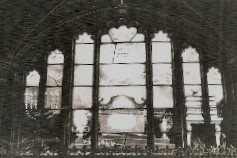Stansted – Chapel
Consecrated in 1819 and incorporating the remains of a C15 brick house.
The chapel is closely linked with Stansted house, which stands nearby. The present one was rebuilt in 1900 in late C17 style by Sir R Blomfield (BE p336) after an early C19 predecessor on the same site had burnt down. The chapel, a little to the south, marks the site of the original C15 house. It was intact in 1700 but was in ruins by 1800 (VCH 4 p121). The Rev Lewis Way (1772-1840) acquired the estate after inheriting £300,000 from John Way, who was no relation, on the basis of their shared name. With the money, he founded a Hebrew College for the conversion of the Jews who, he believed, should be encouraged to go to Palestine. He tried vainly to interest Tsar Alexander I of Russia in the project and died, disheartened, in 1840 (see 2 passim), either in Paris or in a lunatic asylum, according to different sources.
In 1812-15 Way built a chapel around the ruins of the old house. The architect is unknown, though T Hopper, who worked on the contemporary rebuilding of the house, has been suggested (Clarke papers). The chapel was in the parish of Stoughton and was consecrated in 1819 (WSRO Ep I/40/54). Among those present was Way’s friend John Keats, on whom it made a deep impression, expressed particularly in one of his most famous poems The Eve of St Agnes.
The plan of the original house has not been established, but the west end of Way’s chapel, which forms an ante-chapel as at an Oxford or Cambridge college, incorporates the most substantial part. On the evidence of what remains, it dated from c1480. The work includes flint foundations to the north, particularly the north east angle, but the material is otherwise brick, which was formerly stuccoed. The west front of the ante-chapel has a renewed four-centred stone arch with carved spandrels and a four-light square-headed brick window. To the north is a semi-octagonal turret and the brick detail and octagonal turrets of the two-storey south porch also look C15.
The rest of the exterior and the interior date from Way’s time, including the external detail of the ante-chapel, like the battlements and tops of the turrets of the porch. The main chapel has large windows with intersecting tracery of wood and the east window of the short, narrow chancel is set high up with seven lights. The four-centred arch of the porch beneath, which is the usual entry from the present house, may be reset C15 work.
H S Goodhart-Rendel altered the interior in 1925 (A Powers (ed) p54) and again in 1947. The ante-chapel is low, as there is a gallery above and two square-headed windows open into the main chapel. Like the ante-chapel, nave and chancel have flat plaster rib-vaults. That of the nave rests on shafts between the windows and is decorated with foliage at the apex. The front of the gallery is arcaded, with cusped openings on the wall behind the organ. The effect of the white nave would be austere had not Goodhart-Rendel redecorated the chancel in red, blue and gold and painted many fittings. The extraordinary east window (see below), with sombre yet glowing colours, is a miraculous survival. By the plain, segment-headed chancel arch are Hebrew inscriptions.
The chapel belonged in recent years to a large parish consisting of eight churches but because of its position it was concluded that there was no further parochial use for it. Following discussions in 2014-15 it was transferred to the foundation responsible for Stansted house.
Fittings and monuments
Cupboard: (In the passage through doorway south of the chancel arch) Made up from traceried panels that look C15 French or Flemish work.
Font: (Ante-chapel) Large grey marble oval bowl, like a bath, probably for adult baptism.
Glass:
1. (Nave) J Powell and Sons, 1926 (Order book). Bands of armorial glass, renewed on the north side by P Quail, 1959 (DSGW 1961) after damage in World War II.
2. (East window) Mainly brown and yellow in colouring, it contains the symbols of the Jewish faith, arranged without regard for the seven divisions of the window. When restored after war damage, it was found that the glass was painted but not fired (VCH ibid). The glass, ascribed by Martin Harrison to the rarely found J Backler, was a particular inspiration to Keats.
Lectern: Elaborate eagle.
Monuments:
1. (Vestry) Stone figures attributed to E Coade (not in A Kelly or Roscoe).
2. (East wall of nave) Tablets in memory of members of the Bessborough family.
Pulpit: Tall with arcaded sides, with decoration added by Goodhart-Rendel.
Reredos: By Goodhart-Rendel (A Powers (ed) ibid), but entirely in keeping.
Sources
1. Lord Bessborough: A Place in the Forest, 1958
2. : Stansted and its Owners, SCM 26 (Aug 1952) pp356-62


